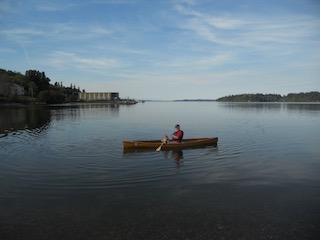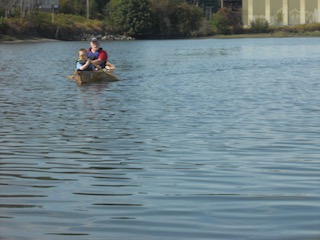A small canoe
27/08/16 06:13

Yesterday, when we arrived to paddle, a couple was unloading a pair of beautiful 17’ composite sea kayaks from the roof of their car. They had their car parked in the turn around to be closer to the water and were just undoing the straps connecting the boats to the rack on the roof of their car when we pulled up. We parked in the lot and I took down my small canoe from the truck and carried it and two paddles to the water while Susan and our grandchildren carried life jackets. My canoe is light and easy to carry by myself. The couple each took one end of one of their boats and carried it to the water and returned for the second boat. After they unloaded the boats they had to park their car.
Meanwhile we launched our boat and my grandson and I paddled out and took a look at a great blue heron and a group of seagulls, explored some old pilings from what might have once been a dock extending into the water, and took a look around. My grandson is just getting the idea of using his own paddle. I have a small 3’ paddle for him to handle and sometimes he can help propel the canoe and other times he just splashes the paddle in the water. He is learning and each time we go out he is more effective than the last time.

As we paddled, I noted that there are two marinas within easy sight of the place were we were paddling. They were filled with recreational boats. There were groups of masts of sailboats ranging from about 25’ to 60’. There were power cruisers and recreational trawlers. Some of those boats are very valuable, costing the amount of a home. We didn’t see any of them out being sailed, however. There were a few whose owners were working on them. Most were sitting waiting while their owners were working.
I have a theory about boats: the bigger the boat, the less often it gets used. Of course that doesn’t apply to the huge transport craft that carry goods all around the world. And it doesn’t apply to tugs and fishing boats that have to be used to earn their living. But when it comes to recreational boats, the larger the boat the more maintenance is required, the more effort it takes to launch and retrieve and the more money is needed to keep things ship shape.
I can unload a canoe from the rack on my truck, haul it to the water and be paddling in about 5 minutes. Even the comparatively short attention spans of 2- and 5-year-old children can tolerate the time it takes to unload and launch the boat. The shoreline is a very interesting place for children, filled with rocks to throw in the water, old chains and pilings to explore, shells and sea creatures to examine, and, of course water that invites wading and splashing on a 90-degree day. By the time we loaded up the boat and headed away, we had two somewhat tired and very soggy kids. Except from a few splashes,they didn’t get wet from paddling in the boat. They got wet waiting between rides in the boat.
Back in the 1990s Richard Bode wrote a small book titled, “First you have to row a little boat.” It is a set of very short essays on the meaning of life - a kind of personal philosophy. It begins with the premise that before you can become a sailor of large craft, you have to learn to properly row a little boat. It has been years since I read the book, but I feel connected to several of the principles expressed in it.
Our grandchildren don’t need their grandpa to have big and fancy boats. They need to paddle a small canoe and experience the joy of playing on the water at this point in their lives. They don’t need expensive toys or extensively organized sports programs. They need gifts of time and attention and creativity. Yesterday was nearly perfect for us. My only regret, and it is a small one, is that I should have simply carved paddles for the children instead of purchasing one. I’ll make their next paddles for them out of some nice, dry Black Hills spruce that I have.
I have no idea whether or not our grandchildren will grow up to be boaters. Whatever happens, they will grow up feeling at home on the water and enjoying the sights and sounds of nature. They will grow up knowing that they are loved and treasured. And that doesn’t require bigger or fancier boats.